非谓语动词的时态和语态精编版共18页
- 格式:ppt
- 大小:2.48 MB
- 文档页数:18
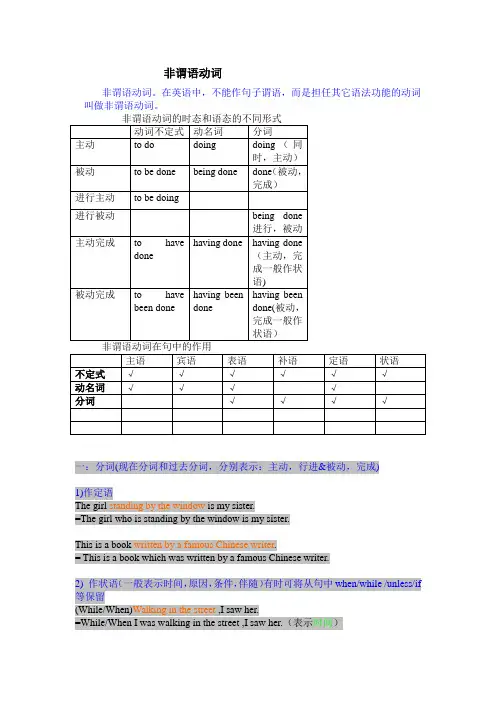
非谓语动词非谓语动词。
在英语中,不能作句子谓语,而是担任其它语法功能的动词叫做非谓语动词。
非谓语动词的时态和语态的不同形式动词不定式动名词分词主动to do doing doing(同时,主动)被动to be done being done done(被动,完成)进行主动to be doing进行被动being done进行,被动主动完成to havedone having done having done(主动,完成一般作状语)被动完成to havebeen done having beendonehaving beendone(被动,完成一般作状语)非谓语动词在句中的作用主语宾语表语补语定语状语不定式√√√√√√动名词√√√√分词√√√√一:分词(现在分词和过去分词,分别表示:主动,行进&被动,完成)1)作定语The girl standing by the window is my sister.=The girl who is standing by the window is my sister.This is a book written by a famous Chinese writer.= This is a book which was written by a famous Chinese writer.2) 作状语(一般表示时间,原因,条件,伴随)有时可将从句中when/while /unless/if 等保留(While/When)Walking in the street ,I saw her.=While/When I was walking in the street ,I saw her.(表示时间)Seen from the hill,our school looks more beautiful.=When our school is seen from the hill,it looks more beautiful.从小山上看,我们学校更美了。


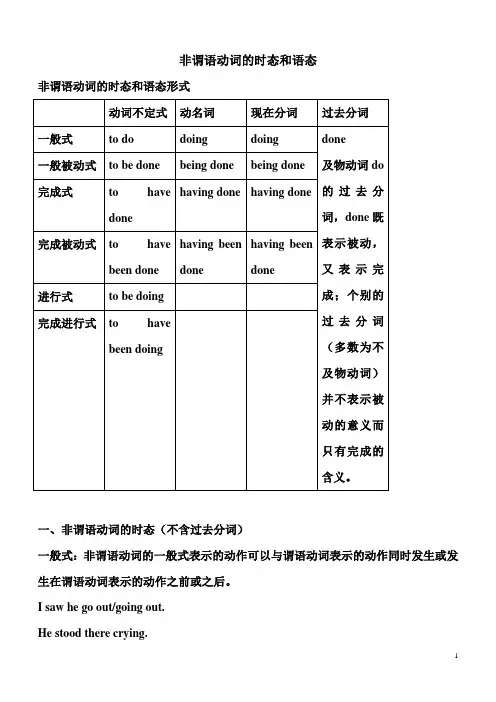
非谓语动词的时态和语态非谓语动词的时态和语态形式一、非谓语动词的时态(不含过去分词)一般式:非谓语动词的一般式表示的动作可以与谓语动词表示的动作同时发生或发生在谓语动词表示的动作之前或之后。
I saw he go out/going out.He stood there crying.He insisted on joining the army.Thank you for giving us so much help.完成式:非谓语动词的完成式表示的动作发生在谓语动词表示的动作之前I am sorry to have kept you waiting.He was praised for having taught for 60 years.Having finished the work he went home.不定式的完成式和完成进行式:只有动词不定式有这两种时态。
其进行式表示的动作正在进行,与谓语动词表示的动作同时发生;其完成进行式表示的动作在谓语动词表示的动作之前一直进行。
They seems to be getting along well now.We’re happy to have been working with you.二、非谓语动词的语态(不含过去分词)一般被动式I’m glad to be invited here.He did it without being asked.The building being built is our school.The book is said to have been translated into chinese.It’ said that 据说…sb./sth. be said to do sth.据说某人某物…She has no memory of having been praised.The plan having been made, he carried it out at once.。

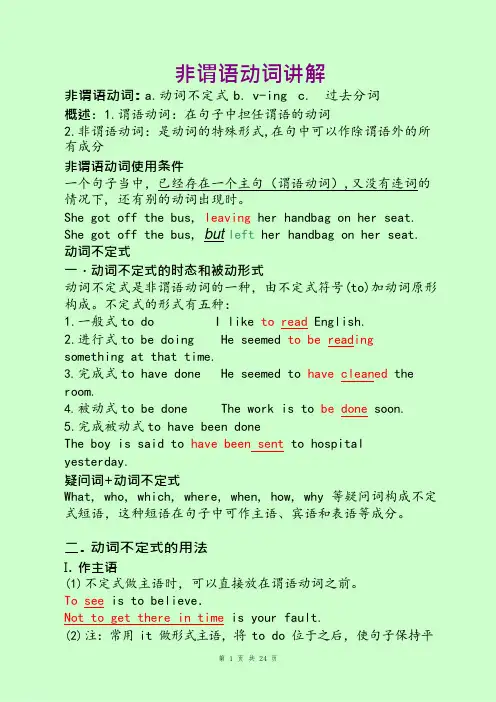
非谓语动词讲解非谓语动词: a.动词不定式b. v-ing c. 过去分词概述:1.谓语动词:在句子中担任谓语的动词2.非谓语动词:是动词的特殊形式,在句中可以作除谓语外的所有成分非谓语动词使用条件一个句子当中,已经存在一个主句(谓语动词),又没有连词的情况下, 还有别的动词出现时。
She got off the bus, leaving her handbag on her seat. She got off the bus, but left her handbag on her seat. 动词不定式一.动词不定式的时态和被动形式动词不定式是非谓语动词的一种,由不定式符号(to)加动词原形构成。
不定式的形式有五种:1.一般式to do I like to read English.2.进行式to be doing He seemed to be reading something at that time.3.完成式to have done He seemed to have cleaned the room.4.被动式to be done The work is to be done soon.5.完成被动式to have been doneThe boy is said to have been sent to hospital yesterday.疑问词+动词不定式What, who, which, where, when, how, why 等疑问词构成不定式短语,这种短语在句子中可作主语、宾语和表语等成分。
二. 动词不定式的用法I.作主语(1)不定式做主语时,可以直接放在谓语动词之前。
To see is to believe.Not to get there in time is your fault.(2)注:常用 it 做形式主语,将 to do 位于之后,使句子保持平衡。
句型 1:It + 谓语 +(+sb.)+时间/金钱+ to doIt takes us an hour _to get there by bus.It costs you only $ 100 a month to cook at home.It seemed impossible to save money.句型 2:It’s + n. (+ for sb) + to doIt’s our duty _t o_h e l p the poor.It is a great enjoyment _to_ spend our holiday in the countryside..It is a great honor for us to be present at your birthday party.句型 3:It is + adj (+ for sb) to do sth(是形容事物的性质的)It is + adj (+ of sb) to do sth(是形容人的品质的)It is easy for me t o f i n i s h this work before ten.It is very kind of you t o g i v e me some help.It's impolite of you to speak to the teacher like that.疑问词+不定式作主语When to start remains undecided.1.It is easy to get there by bus or taxi.2.It takes about 3 hours to see all the birds.3.It is also impolite to speak with your mouth full when you are eating.4.It’s our duty to take good care of the old.5.How long did it take you to finish the work?6.It is stupid of you to write down everything the teacher says.7.When to start has not been decided.8.It seemed selfish of him not to give them anything.9.It’s necessary for you to lock the car when you do not use it.10.It is useful for our health to do morning exercises.II.作宾语接不定式做宾语 I want to know this matter.I don’t expect to meet you here(1)常见动词有:like, demand, expect, promise, begin, determine, refuse, fail, manage, learn, seem, forget, want, prepare, pretend, plan, wish 等They want to get_( get ) on the bus, didn’t they?He said he wishedt o b e(b e)a p r o f e ss o r.(2)it 作形式宾语I find/feel to work with him interesting .I find/feel it interesting to work with him.Subject+ find/think/feel/make/ consider… it+adj/n + to do sth.1.We thought _it better to_ start early.2.Do you consider _it better not _to_ go?3. I feel _it_ my duty _to_ change all that.4.We think it important _ to _ obey the law.5.I know _ it _ impossible _ to _ finish so much homework in a day.(3)疑问词+不定式作宾语常常放在这些动词的后面作宾语:tell, advise, show, teach, find out, decide, discuss, learn, explain…He taught us how to use the tool.No one could tell me where to get the book.The dictionary didn’t tell the Frenchman how to pronounce the word.(4)作介词 but, except, besides 的宾语。

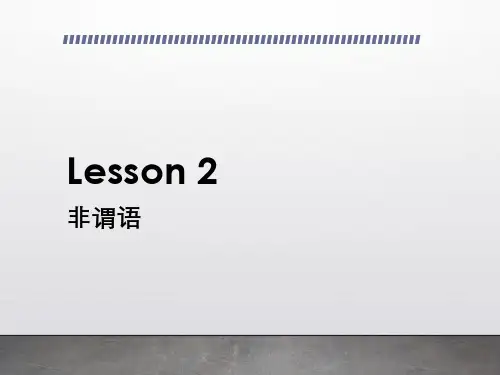
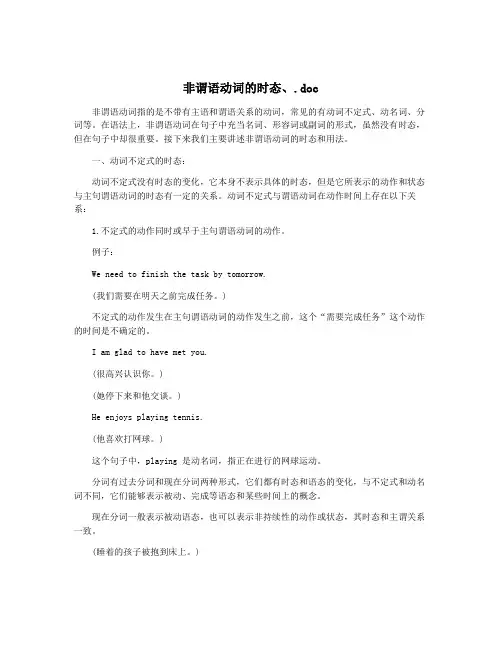
非谓语动词的时态、.doc非谓语动词指的是不带有主语和谓语关系的动词,常见的有动词不定式、动名词、分词等。
在语法上,非谓语动词在句子中充当名词、形容词或副词的形式,虽然没有时态,但在句子中却很重要。
接下来我们主要讲述非谓语动词的时态和用法。
一、动词不定式的时态:动词不定式没有时态的变化,它本身不表示具体的时态,但是它所表示的动作和状态与主句谓语动词的时态有一定的关系。
动词不定式与谓语动词在动作时间上存在以下关系:1.不定式的动作同时或早于主句谓语动词的动作。
例子:We need to finish the task by tomorrow.(我们需要在明天之前完成任务。
)不定式的动作发生在主句谓语动词的动作发生之前,这个“需要完成任务”这个动作的时间是不确定的。
I am glad to have met you.(很高兴认识你。
)(她停下来和他交谈。
)He enjoys playing tennis.(他喜欢打网球。
)这个句子中,playing 是动名词,指正在进行的网球运动。
分词有过去分词和现在分词两种形式,它们都有时态和语态的变化,与不定式和动名词不同,它们能够表示被动、完成等语态和某些时间上的概念。
现在分词一般表示被动语态,也可以表示非持续性的动作或状态,其时态和主谓关系一致。
(睡着的孩子被抱到床上。
)过去分词形式分为 Regular 和 Irregular 两类。
Irregular 过去分词形式不规则,与动词原形不同(如 go –gone, eat –eaten),而 Regular 过去分词形式与原形相同,加 -ed(如 play – played,work – worked)。
(凯特已经完成了她的工作。
)在这个句子中,finished 是过去分词,表示完成了的状态。
四、总结:1.动词不定式、动名词和分词都没有时态的变化。
2.动词不定式和动名词的用法和谓语动词的位置有关。
3.分词的时态和语态与主谓关系一致,但要根据实际情况使用。
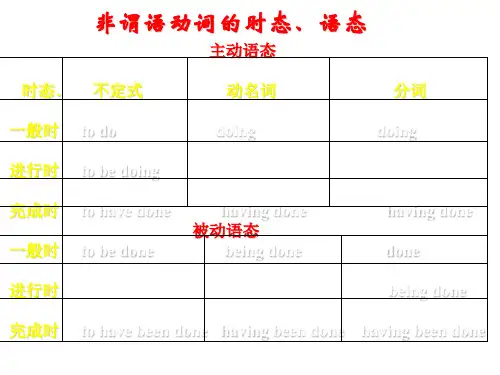

非谓语动词的时态和语态(最新版)编制人:__________________审核人:__________________审批人:__________________编制单位:__________________编制时间:____年____月____日序言下载提示:该文档是本店铺精心编制而成的,希望大家下载后,能够帮助大家解决实际问题。
文档下载后可定制修改,请根据实际需要进行调整和使用,谢谢!并且,本店铺为大家提供各种类型的经典范文,如词性大全、句法大全、句型大全、从句大全、时态大全、语态大全、语法大全、虚拟语气、用法辨析、其他资料等等,想了解不同范文格式和写法,敬请关注!Download tips: This document is carefully compiled by this editor.I hope that after you download it, it can help you solve practical problems. The document can be customized and modified after downloading, please adjust and use it according to actual needs, thank you!In addition, this shop provides you with various types of classic sample essays, such as part of speech, syntax, sentence pattern, clause, tense, voice, grammar, subjunctive, usage analysis, other materials, etc. If you want to know the different formats and writing methods of the model essay, please pay attention!非谓语动词的时态和语态1. 非谓语动词的时态不定式或现在分词的动作若发生在谓语动词的动作之前,用完成式(过去分词没有完成式),否则,就用一般式。
非谓语动词总结(高考完整版)一、非谓语动词的含义非谓语动词首先是一种动词形式,其次是这种动词形式不能做谓语,综合这两点,我们将其叫做非谓语动词。
老师进来时,她假装正在读书。
④完成时:to have done(表示主动和完成)eg: The thief is said to have escaped.据说小偷已经逃跑了。
⑤完成被动式:to have been done(表示被动和完成)eg:The thief is said to have been arrested.据说小偷已经被抓住了。
⑥完成进行式:to have been doing (表示主动和完成进行)eg: She is said to have been working in the factory over the last 20 years.据说在过去的20年里,她一直在这家工厂工作。
(2)动名词①基本形式:doing (表示主动)eg: Travelling in space by ordinary people will be common in the future.在未来,普通人在太空旅行将会是普遍的事情。
②被动式:being done(表示被动)eg: Freddy and his band could go nowhere without being followed by their fans.弗雷迪和他的乐队到哪里都被他们的粉丝跟着。
③完成式:having done(表示主动和完成)eg: I have no idea of his having done such a thing against you.我不知道他做过这样一件违背你的事情。
④完成被动式:having been done(表示被动和完成)eg: Many customers complain of having been given short weight at that shop.很多顾客抱怨在那家商店被缺斤少两过。
非谓语动词在句中充当除谓语以外的句子成分的动词形式叫做非谓语动词。
非谓语动词分为三种形式:不定式、动名词和分词(分词包括现在分词和过去分词)不定式、动名词和现在分词都有时态和语态的变化.不定式主动语态被动语态与谓语动词的关系一般式To do To be done 动作发生在谓语动作之后进行式To be doing 与谓语动作同时发生完成式To have done To have been done 动作发生在谓语动作之前动名词主动语态被动语态与谓语动词的关系一般式Doing Being done 与谓语动作同时发生完成式Having doing Having been done 动作发生在谓语动作之前现在分词主动语态被动语态与谓语动词的关系一般式Doing Being done 与谓语动作同时发生完成式Having done Having been done 动作发生在谓语动作之前不定式一、不定式的作用1、作主语不定式作主语时,谓语用单数。
往往用it 作形式主语,把不定式放在谓语后面。
如:It took us two hours to finish the job.It is impossible for us to get there on time.It is very kind of you to help us.注意:(1)其他系动词如look, appear等也可用于此句型。
(2)当不定式作主语的句子中又有一个不定式作表语时,不能用It is …to…的句型。
试比较:It is to negate my own idea to believe him.(错)To believe him is to negate my own idea .(对)(3)It is+ adj. of / for sb. to do sth. 结构中,当不定式的逻辑主语和前面的形容词可以构成系表结构时,用of, 否则用for.2、作宾语(1)动词+不定式。
非谓语动词的时态和语态
非谓语动词不具有时态和语态。
非谓语动词包括动词不定式、动名词和分词(包括现在分词和过去分词)。
它们不受主语的人称和数的影响,也不受谓语动词的时态和语态的限制。
例如:
- 动词不定式:to eat(吃)
- 现在时:I like to eat fruit.(我喜欢吃水果。
)
- 过去时:He wanted to eat dinner.(他想吃晚饭。
)- 动名词:eating(吃)
- 现在时:I enjoy eating ice cream.(我喜欢吃冰淇淋。
)
- 过去时:She remembered eating lunch at the restaurant.(她记得在餐厅吃午饭。
)
- 现在分词:eating(吃)
- 主动语态:I saw a man eating an apple.(我看到一个人在吃苹果。
)
- 被动语态:The cake being eaten was delicious.(被吃掉的蛋糕很好吃。
)
- 过去分词:eaten(吃)
- 主动语态:He has eaten breakfast.(他已经吃过早饭了。
) - 被动语态:The cake eaten by him was tasty.(被他吃掉的蛋糕很好吃。
)。
非谓语动词时态和语态的结构1.不定式有哪些时态和语态呢?主动被动一般时to do to be done进行时t o b e do i n g无完成时to have done to have been done 完成进行式t o h a v e b ee n do i n g无2.动名词的时态和语态主动被动一般时do i n g b e i n g do n e完成时h a v i n g done h a v i n g b ee n done 3.分词的时态和语态主动被动现在分词一般时do i n g b e i n g do n e现在分词完成时h a v i n g do n e h a v i n g b ee n do n e过去分词无done中考英语非谓语动词总结一.接动词不定式( to do/ do sth)1.do n o t h i n g b u t do s t h除了做某事外不做任何事2.be supposed to do sth应该做某事;被期望干某事3.L e t's(n o t)do s t h4.w a n t t o do s t h5.w a n t s b t o do s t h7.ask sb (not ) to do sth 8.s t opt o do s t h停下来去做某事9.t e lls b(n o t)t o do s t h 10.w a t c h s bdo s t h观察某人做某事11.I t's t i m e(f o r s b)t o do s t h到了该去做某事的时间12.h e l p s b(t o)do s t h13.h e l p do s t h14.m ak e s b do s t h15.d e c i d e(n o t)t o do s t h决定做某事16.f i n d i t+a d j+t o do s t h17.h a v e t o do s t h必须做某事18.t r y(n o t)t o do s t h尽力做某事19.t r y o n e's b e s t t o do s t h尽某人最大能力做某事20.I t's+a d j+(f o r)o f+s b+t o do s t h21.p l a n t o do s t h计划去做某事22.S.p.+b e a good p l a c e t o do s t h23.I t t ak e s s b+s o m e t i m e+t o do s t h做某事花费某人多长时间24.s e n d s b t o do s t h派某人做某事25.i n v i t e s b t o do s t h邀请某人做某事26.f o r g e t t o do s t h忘记要去做某事27.li v e t o b e+时间活到…28.b e a b l e t o do s t h能够做某事29.h a v e s t h t o do有事要做30.s ee m t o do s t h似乎做;好像31.g e t s b/s t h t o do s t h32.疑问词+ to do sth33.need sth to do sth需要……做某事34.u s e s t h t o do s t h用某物来做某事35.f o ll o w s b t o do s t h跟随某人做某事36.n ee d t o do s t h需要做某事37.a good t i m e t o do s t h做某事的好时候38.t h e b e s t t i m e t o do s t h做某事的最好时间39.t h e b e s t w a y t o do s t h做某事最好的方法40.b e t h e f i r s t/l a s t o n e t o do s t h最后一个或者第一个(人或事吧)去做某事41.w o u l d li k e t o do s t h想要做某事42.b e e x c i t e d/s u r p r i s e d t o do s t h对做某事感到兴奋43.b e u s e f u l t o do s t h有助于做某事44.b e a ll o w e d t o do s t h被允许做某事45.a ll o w s b t o do s t h允许某人做某事46.I t's b e tt e r t o do s t h干某事比较好47.I t's b e s t t o do s t h48.t ak e c a r e(n o t)t o do s t h小心(不要)做某事49.s ee s b do s t h看见某人做了某事50.why not do sth ?51.h a v e e n o u g h t i m e t o do s t h有足够的时间干某事52.t oo…t o do s t h太…以至于不能53.not… enough to do sth 不 ----- 足够做某事54.encourage sb to do sth鼓励某人做某事55.c h oo s e t o do s t h选择做某事56.w a i t t o do s t h等着做某事57.b e h a pp y/g l a d/p l e a s e d t o do s t h高兴做某事58.m ak e i t+a d j+t o do s t h59.b e c a r e f u l t o do s t h小心做某事60.b e a f r a i d t o do s t h害怕去做某事61.I t's o u r d u t y t o do s t h做某事是我们的责任62.u s e d t o do s t h过去常做某事63.c a n't a ff o r d t o do s t h不能担负起干某事64.m ak e a d e c i s i o n t o do s t h决定做某事65.h a v e a n oppo r t un i t y t o do s t h有做某事的机会66.w a i t f o r s b t o do s t h等待某人做某事67.w o u l d do s t h r a t h e r t h a n do s t h宁愿做某事不愿做某事68.w o u l d r a t h e r do s t h t h a n do s t h宁愿做某事不愿做某事69.hu rr y t o do s t h匆忙去做某事70.r e f u s e t o do s t h拒绝干某事71.a g r ee t o do s t h同意干某事72.p r e t e n d t o do s t h假装做某事73.p r e t e n d t o b e do i n g s t h假装正在做某事74.p r e f e r t o do s t h更喜欢做某事75.p r e f e r n o t t o do s t h76.p r e f e r t o do s t h r a h e r t h a n do s t h77.b e w illi n g t o do s t h乐意去做某事78.v o l un t ee r+时间/钱+t o do s t h79.v o l un t ee r t o do s t h自愿去做某事80.o ff e r t o do s t h提出要做…81.rush to do sth赶着做某事82.i n o r d e r(n o t)t o do s t h为了做某事83.b e c e r t a i n t o do s t h一定做…84.b e s u r e t o do s t h一定会做某事85.m ak e p l a n s t o do s t h制定计划做某事86.go o u t o f o n e’s w a y t o do s t h特别费心地(为某人)做某事87.l e a d s b t o do s t h致使某人做某事88.w a r n s b t o do s t h警告某人做某事89.I t's o n e's t u r n t o do s t h该轮到某人做某事90.u r g e s b t o do s t h敦促某人做某事91.C o u l d/W o u l d y o u p l e a s e(n o t)do s t h?请你(不要)做某事好吗?92.it is great fun to do sth做…很有趣二、接动名词(do i n g s t h)1.li k e do i n g s t h2.e n j o y do i n g s t h喜欢做某事3.h a v e g r e a t f un do i n g s t h做…玩得很高兴4.b e i n t e r e s t e d i n do i n g s t h对做某事感兴趣5.T h a n k s f o r do i n g s t h感谢某人做某事6.l oo ka t sb do i n g s t h看到某人做某事7.s t op s bdo i n g s t h阻止某人做某事8.s t op s b f r o m do i n g s t h阻止某人做某事9.go+v-i n g10.do t h e(s o m e)+v-i n g11.W h a t/H o w do i n g s t h?12.p r a c t i c e do i n g s t h练习做某事13.w a t c h s b do i n g s t h观察某人正在做某事14.f i n d s b do i n g s t h发现某人正在做某事15.m i n d(o n e's)do i n g s t h介意(某人)做某事。